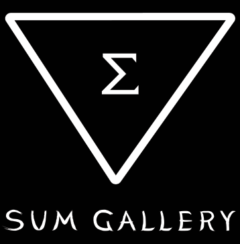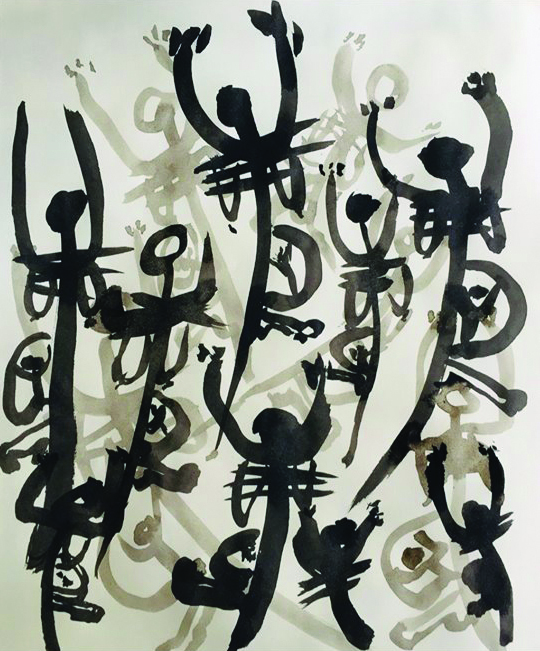The pop up exhibition running, running, trees go by… shows at SUM Gallery from August 20-25 during the 2019 Vancouver Queer Film Festival. Curated by Festival Programmer Justin Ducharme, it features new and retrospective works by Zachery Longboy.
Longboy is from Churchill, Manitoba and is of Sayisi Dene lineage. The collection continues the artists’ exploration within a fractured cultural experience through deeply felt layered videos, paintings and archival film.
Justin Ducharme (JD) and Zachery Longboy (ZL) talk to SUM Gallery about the exhibition:
Justin, what draws you to Zachery Longboy as an artist and made you want to exhibit his work?
JD: I first saw water into fire, a film by Zachery a few years ago when I was about 20 years old and I was instantly drawn to the performance aspect of the piece. The work was self reflective on his identity has an indigenous man living with HIV and there was this unfiltered approach to his making that I was instantly drawn to. I discovered Zachery around the same time I became familiar with Thirza Cuthand’s work and I admire the way they both approached filmmaking from both a performance and technical angle. I knew I was going to be making work myself as an artist that is self reflective of my intersecting identities so finding folks who were doing that in ways that felt completely new to me meant a lot. Most of my film work is narrative based but I’ve drawn heavily from people like Zachery and Thirza who have made performative documentary work. Kinship and community is a huge part of why I am where I am as a creator and human being. I can say 100% with my gut that I would not be the artist or person I am without my kin or artists like Zachery.
Zachery, what made you trust Justin and embark on this collaboration? Were you actively pursuing exhibition opportunities or was there a particular calling that brought you to SUM?
ZL: There was no reason not to trust Justin, I had been thinking about pursuing an exhibition; however, never got beyond the thinking. I have always enjoyed collaboration and this has been the perfect opportunity to work with the Vancouver Queer Film Festival, SUM Gallery and Justin. He had a clear vision of how he saw my work presented and what it meant to him. I drew these works over the last 2 years and there is a movement that flows through all: community, difference, search for belonging and acceptance. I began animating the drawings and posting them on Instagram. That’s where Justin saw the work.
How did you select the works? All of the pieces are new except for the stone show although it too has been reimagined. What is the artistic statement behind these new pieces? What do you hope people take away from the show?
JD: We selected the works over the course of one afternoon back in July. It was pretty chill how it all came about. We started by talking about healing actually, cuz I was going through some shit and we mutually bonded over our sad boi identities. I thought about colour palette first because Zachery has such an expansive collection of drawings and paintings. We both connected to the greyscale black and white works and knew we wanted to keep the majority of pieces in the exhibit that tone.
ZL: We decided early on that the work had to stand for itself, circumventing the traditional title and explanations cards. Let the viewer enjoy and experience the work without the clutter of explanation.
JD: We talked a lot about trusting our audience. It was kind of fitting that the theme of VQFF this year is See for Yourself because that is exactly what we are asking people to do. Something Zachery and I both love is showing someone something and then allowing them to discuss what it means to them or how it makes them feel. We didn’t want to spoon feed a narrative to anyone. Come and be immerrsed in the work and draw from it what you will. We both connect to the peices in there for different reasons and that’s the beauty of it I think.
There are no title cards for the pieces – is there a story behind why that is? Does this create a barrier between the viewer and the art or does it allow for a more personal relationship to the pieces?
JD: I personally don’t think it creates a barrier for people to connect to the pieces. Something I have been struggling with lately is this whole idea of having to name something when it’s finished. We have titles and terms for so many different things in the english language and it’s just not like that in most indigenous languages or others for that matter. Sometimes there are no words for things, and that is okay.
The stone show has been revisited – cut from an hour of original footage down to a fifteen minute video. What motivated this? Has the piece become something different through its reconstruction?
JD: Mainly obsession. I desperately wanted to include an archival piece in the exhibit and we talked for a bit about what that would look like. I had seen the orignal hour long show via footage from grunt gallery and was so connected to the visuals and spoken word aspect of the piece. Being a filmmaker myself I was up for the challenge of giving it a recut and suggested it to Zachery after grunt let me know they had the VHS footage available. For me it now feels like a cinematic love letter to knowing but not knowing who you are and where you come from. The spoken word aspect, the physicality of the piece, everything was so incredibly emotion inducing.
Justin, you work as a festival programmer for Vancouver Queer Film Festival. Is there a particular film at this year’s festival that you can recommend which speaks to this exhibition?
JD: Yes I can think of one in particular that I’d like to shout out. Wildfire by Bretten Hannam is a short film that is screening on Friday, Aug 24th at The York Theatre in a shorts program I curated titled all our relations: explorations on indigiqueer kinship. The film follows two Mi’kmaw teens on the run from one of their abusive stepfathers and lets the viewer see how their kinship grows through this experience. When I think of running running trees go by… I think about the journey Zachery and I took together, I think about movement, about community, about pain and longing, about kinship. I think Wildfire discusses these themes in a way that is so singular to Brettens filmmaking, so while I don’t think the comparison necessarily slaps you across the face right away I think that if you dig deep you might find something you didn’t see before.

